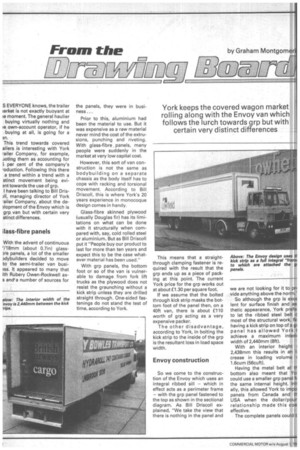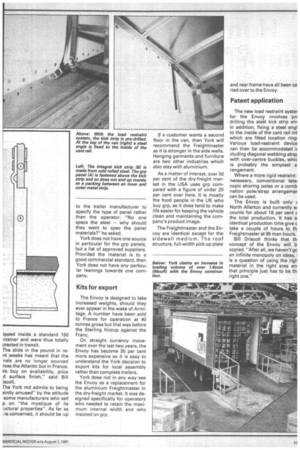From the
Page 34

Page 35

If you've noticed an error in this article please click here to report it so we can fix it.
by Graham Montgome York keeps the covered wagon market rolling along with the Envoy van which follows the lurch towards grp but with certain very distinct differences
S EVERYONE knows, the trailer larket is not exactly buoyant at le moment. The general haulier buying virtually nothing and is own-account operator, if he buying at all, is going for a an.
This trend towards covered ailers is interesting with York railer Company, for example, Joting them as accounting for i per cent of the company's roduction. Following this there a trend within a trend with a stinct movement being eviant towards the use of grp.
I have been talking to Bill Dris)11, managing director of York -ailer Company, about the dealopment of the Envoy which is grp van but with certain very stinct differences.
ilass-fibre panels
With the advent of continuous r/18mm (about 0.71n) glassre panels, a lot of the smaller ›dybuilders decided to move to the semi-trailer van busiass. It appeared to many that ith Rubery Owen-Rockwell axs and'a number of sources for the panels, they were in business ...
Prior to this, aluminium had been the material to use. But it was expensive as a raw material never mind the cost of the extrusions, punching and riveting. With glass-fibre panels, many people were suddenly in the market at very low capital cost.
However, this sort of van construction is not the same as bodybuilding on a separate chassis as the body itself has to cope with racking and torsional movement. According to Bill. Driscoll, this is where York's 20 years experience in monocoque design comes in handy.
Glass-fibre skinned plywood (usually Douglas fir) has its limitations on what can be done with it structurally when compared with, say, cold rolled steel or aluminium. But as Bill Driscoll put it "People buy our product to last for more than ten years and expect this to be the case whatever material has been used."
With grp panels, the bottom foot or so of the van is vulnerable to damage from fork lift trucks as the plywood does not resist the graunching without a kick strip unless they are drilled straight through. One-sided fastenings do not stand the test of time, according to York. This means that a straightthrough clamping fastener is required with the result that the grp ends up as a piece of packing at this point. The current York price for the grp works out at about £1.30 per square foot.
If we assume that the bolted through kick strip masks the bottom foot of the panel then, on a 40ft van, there is about £110 worth of grp acting as a very expensive packer.
The other disadvantage, according to York, in bolting the kick strip to the inside of the grp is the resultant loss in load space width.
Envoy construction
So we come to the construction of the Envoy which uses an integral ribbed sill — which in effect acts as a perimeter frame — with the grp panel fastened to the top as shown in the sectional diagram. As Bill Driscoll explained, "We take the view that there is nothing in the panel and we are not looking for it to pro vide anything above the norm'
So although the grp is ex lent for surface finish and thetic appearance, York prep to let the ribbed steel belt most of the structural work. NI having a kick strip on top of a panel has allowed York I achieve a maximum into ii width of 2,440mm (8ft).
With an interior height• 2,438mm this results in an Ii crease in loading volume 1.6cum (56cuft).
Having the metal belt at bottom also meant that Y could use a smaller grp panel the same internal height. ally, this allowed York to in", panels from Canada and It USA when the dollar/poor relationship made this Coe effective.
The complete panels could, k
ipped inside, a standard 150 ntainer and were thus totally otected in transit.
The slide in the pound in rent weeks has meant that the nels are no longer sourced ross the Atlantic but in France. Ve buy on availability, price d surface finish," said Bill iscoll.
The York md admits to being aintly amused" by the attitude some manufacturers who self p on "the mystique of its .uctural properties". As far as is concerned, it should be up
to the trailer manufacturer to specify the type of panel rather than the operator. "No one specs the steel — why should they want to spec the panel materials?" he asked.
York does not have one source in particular for the grp panels, but a list of approved suppliers. Provided the material is to a good commercial standard, then York does not have any particular leanings towards one company.
Kits for export
The Envoy is designed to take increased weights, should they ever appear in the wake of Armitage, A number have been sold to France for operation at 40 tonnes gross but that was before the Sterling hiccup against the Franc.
On straight currency movement over the last two years, the Envoy has become 35 per cent more expensive so it is easy to understand the York decision to export kits for local assembly rather than complete trailers.
York does not in any way see the Envoy as a replacement for the aluminium Freightmaster in the dry-freight market. It was designed specifically for operators who needed to retain the maximum internal width and who insisted on grp. (f a customer wants a second floor in the van, then York will recommend the Freightmaster as it is stronger in the side walls. Hanging garments and furniture are two other industries which also stay with aluminium.
As a matter of interest, over 50 per cent of the dry-freight market in the USA uses grp compared with a figure of under 20 per cent over here. It is mostly the food people in the UK who buy grp, as it does tend to make life easier for keeping the vehicle clean and maintaining the company's product image.
The Freightmaster and the Envoy are identical except for the sidewall medium. The roof structure, full-width pick up plate and rear frame have all been ea ried over to the Envoy.
Patent application
The new load restraint systet for the Envoy involves pri drilling the steel kick strip an in addition, fixing a steel angl to the inside of the cant rail int which are fitted location ring: Various load-restraint device can then be accommodated ir cluding diagonal webbing strap with over-centre buckles, whic is probably the simplest a rangement.
Where a more rigid restraint necessary, conventional tele: copic shoring poles or a comb nation pole/strap arrangemer can be used.
The Envoy is built only North Allerton and currently a( counts for about 18 per cent c the total production. It has a identical production time give c take a couple of hours to th Freightmaster at 95 man hours.
Bill Driscoll thinks that th concept of the Envoy will b copied. "After all, we haven't gc an infinite monopoly on ideas. I is a question of using the righ material in the right area an that principle just has to be th, right one."








































